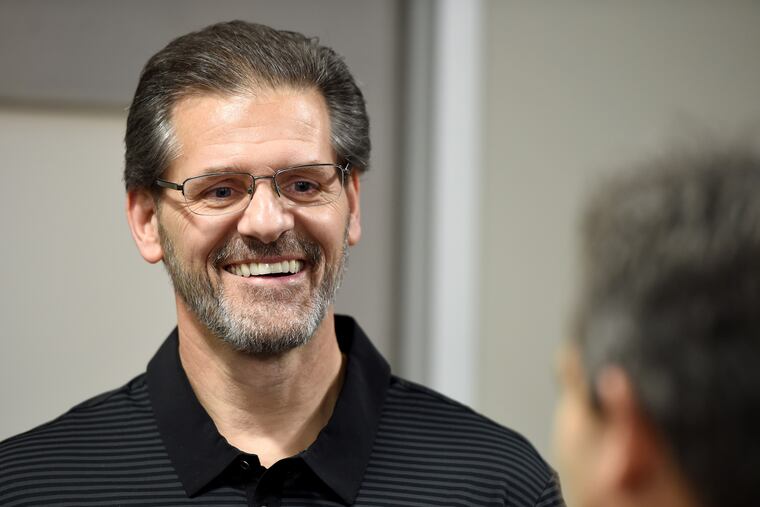All you need to know about Ron Hextall and his Flyers plan comes down to one trade | Mike Sielski
When the Flyers' GM traded Brayden Schenn to the Blues at last year's NHL draft, he got back two first-round draft picks. More important, he showed some astute long-term thinking.

The NHL draft will be held this week, over Friday, June 22, and Saturday, June 23, which gives Ron Hextall reason to talk the other day about last year's NHL draft, in which something magical happened for the Flyers. I don't mean magical in the way the word is often used in sports, as a synonym for marvelous or extraordinary. I mean magical in its strictest definition, in that something that was in front of everyone's eyes became something else without anyone seeing it happen. Anyone, that is, except Hextall and the Flyers' scouting staff, and the fact that they saw it lends some insight into his approach for rebuilding the team's roster.
First, some stage-setting is required: In July 2016, Brayden Schenn signed a four-year, $20.5 million contract with the Flyers, lucrative for him but – and this is important in a salary-cap league – still manageable and movable if Hextall, the team's general manager, decided to trade him. Then, in 2016-17, Schenn had a pretty good season. He led the NHL in power-play goals, with 17, and finished with 25 goals overall. The Flyers did not have a pretty good season. They missed the playoffs.
Now, let's move to June 2017. Ahead of that draft, TSN super scout Craig Button had Morgan Frost, a center with the Sault Ste. Marie Greyhounds of the Ontario Hockey League, as the 49th-best available prospect. Hextall and the Flyers scouts believed Frost to be a much better prospect than that; they believed him to be a first-round talent. "Every guy on our staff liked Morgan Frost," Hextall said. As the first round progressed, it became apparent that the Flyers might be outliers when it came to their unanimous evaluation of Frost, which meant that if they made the right trade at the right time, they could get him – and perhaps some additional assets, too.
To pull off such a trade, though, they would have to sacrifice something of value – a good player, other draft picks. That something was Schenn; the Flyers traded him to the Blues for Jori Lehtera, the 27th pick in that draft, and a conditional first-round pick in this draft. With that 27th pick, the Flyers took Frost.
"We made that trade [because] OK, now it's not a first-round pick," Hextall said. "It's Morgan Frost."
>>READ MORE: Carter Hart is still the heart of the Flyers' 'Process'
That's the magical part of the whole thing. When media and fans judge trades such as this one, they often view a draft pick solely as a lottery ticket with varying odds of paying off, depending on how high it is. That more-analytical thinking is vital and necessary to any franchise in any sport that is trying to accumulate talent and establish/maintain success, but it's not everything. Those picks become players, too, and that transformation was at the core of Hextall's reason for making that trade. It wasn't just that the Flyers could get two first-round picks for Schenn. It was that one of those picks would be a particular player whom the Flyers, more than any other team, had judged to be particularly valuable.
This sort of move, made with an eye toward the Flyers' long-term future, has become common from Hextall, even if it can still seem a bit surprising and unusual in the context of the franchise's tradition of making an annual pell-mell charge toward the Stanley Cup. For those already tiring of watching the Flyers offer a mediocre on-ice product in recent years, it's easy to view this trade as a frustrating example of Hextall's being too unaggressive. Schenn, after all, posted career highs in goals (28), assists (42), and points (70) for the Blues last season, and Lehtera was a fourth-line player at best.
But if you take a step back, a broader context puts the deal in a different light. Schenn's statistics, one could argue, were goosed by his role with the Blues. (He started in the offensive zone for 64 percent of his even-strength faceoffs – by far the highest percentage of his career.) Meanwhile, Frost, who turned 19 just last month, had a terrific 2017-18 season for Sault Ste. Marie – 42 goals and 70 assists in just 67 games – and is regarded as one of the Flyers' top prospects. "Right now," Hextall said, "he's a better player than where he was drafted."
As for this year's draft, the Flyers have nine picks, including two in the first round, the 14th and 19th overall. And of those two first-rounders, the No. 14 pick – the better pick – is the one they got in the Schenn trade. Hextall might use all nine. He could package one or more in a trade. Either way, the Flyers have a measure of flexibility they once didn't. That doesn't necessarily guarantee that something magical will happen for them, that they'll achieve the consistent excellence that Hextall is shooting for. It means only that there's a better chance they will. Which is the point.